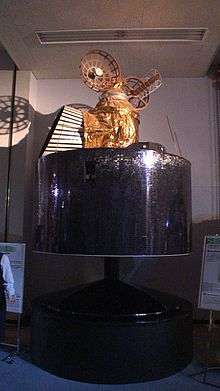Himawari (satellite)
"Geostationary Meteorological Satellite" redirects here. For meteorological satellites in geostationary orbit, see weather satellite.

GMS, the first generation of Himawari
The Himawari (ひまわり, “sunflower”) geostationary satellites, operated by the Japan Meteorological Agency (JMA), support weather forecasting, tropical cyclone tracking, and meteorology research. Most meteorological agencies in East Asia, Southeast Asia, Australia and New Zealand use the satellites for their own weather monitoring and forecasting operations.
Since the launch of GMS-1 (Himawari 1) in 1977, there have been three generations, including GMS, MTSAT, and Himawari 8/9. Himawari 8 and MTSAT-2 satellites are currently available for operational use.
Status of Himawari satellites
| Name | Launch date (UTC) |
Retirement | Rocket | Launch site |
|---|---|---|---|---|
| GMS-1 (Himawari 1) | 14 July 1977 | June 1989 | Delta 2914 | Cape Canaveral |
| GMS-2 (Himawari 2) | 11 August 1981 | November 1987 | N-II (N8F) | Tanegashima |
| GMS-3 (Himawari 3) | 3 August 1984 | June 1995 | N-II (N13F) | Tanegashima |
| GMS-4 (Himawari 4) | 6 September 1989 | February 2000 | H-I (H20F) | Tanegashima |
| GMS-5 (Himawari 5) | 18 March 1995 | July 2005 | H-II (F3) | Tanegashima |
| MTSAT-1 (Mirai 1) | 15 November 1999 | Launch failure | H-II (F8) | Tanegashima |
| MTSAT-1R (Himawari 6) | 26 February 2005 | 4 December 2015 | H-IIA (F7) | Tanegashima |
| MTSAT-2 (Himawari 7) | 18 February 2006 | Stand-by | H-IIA (F9) | Tanegashima |
| Himawari 8 | 7 October 2014 | Operational | H-IIA (F25) | Tanegashima |
| Himawari 9 | 2 November 2016 | Commissioning | H-IIA (F31) | Tanegashima |
See also
References
External links
This article is issued from Wikipedia - version of the 11/5/2016. The text is available under the Creative Commons Attribution/Share Alike but additional terms may apply for the media files.